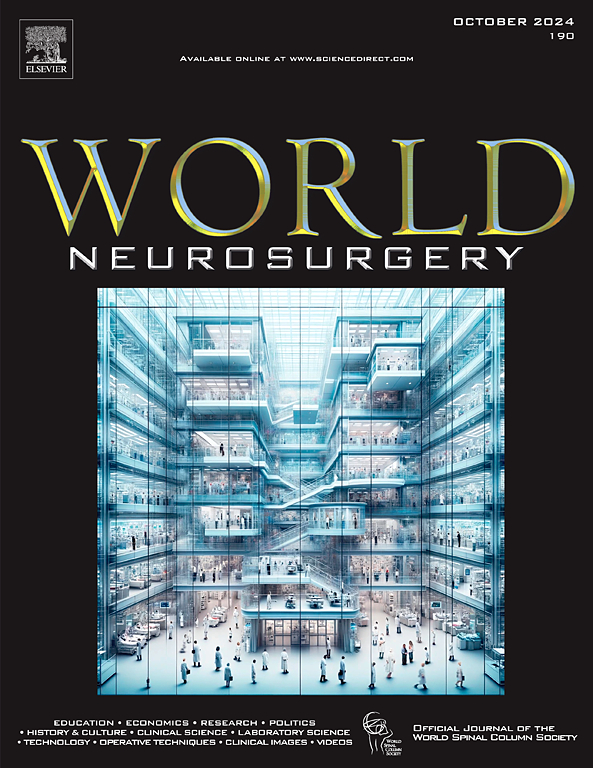Simple Reconstruction Method of Dural Defects for Minimal Anterior and Posterior Combined Transpetrosal Approach
IF 1.9
4区 医学
Q3 CLINICAL NEUROLOGY
引用次数: 0
Abstract
Background
The minimal anterior posterior combined (MAPC) transpetrosal approach is a valuable technique for accessing petroclival lesions with supra-infratentorial extensions. However, dural reconstruction following this approach presents significant challenges owing to subtemporal and presigmoid dural and transtentorial incisions, dural shrinkage resulting from coagulation, and spatial constraints.
Methods
This study retrospectively examined 25 patients who underwent MAPC transpetrosal approach between 2022 and 2024. We employed a simplified method of dural reconstruction using a fat graft and a sternocleidomastoid muscle-periosteum-temporal fascia flap without suturing. An absorbable polyglycolic acid material was fixed along the flap using fibrin glue to reinforce the sealing of the dura (question number 4, reviewer #1). The evaluation was conducted with a focus on subcutaneous cerebrospinal fluid (S-CSF) collection based on postoperative magnetic resonance imaging findings, and the strategies employed to address this complication were assessed.
Results
Of the 25 cases examined, 16 showed no evidence of S-CSF accumulation (grade 0). Two patients were classified as grade 1, while 7 patients exhibited grade 2 S-CSF collection. None of the patients experienced cerebrospinal fluid (CSF) leakage through the surgical incision nor did they develop CSF rhinorrhea or otorrhea. All instances of S-CSF accumulation resolved spontaneously within 2–6 weeks, without requiring surgical intervention. Only 1 patient with a history of repeat surgery required CSF diversion via a lumbar drain postoperatively.
Conclusions
The simple dural reconstruction method using autologous fat graft and sternocleidomastoid temporal fascia flap demonstrated promising results in terms of preventing CSF-related complications following the MAPC transpetrosal approach.
经脊骨联合入路硬脑膜缺损的简易重建方法。
背景:最小前后联合(MAPC)经窦入路是一种有价值的技术,用于治疗伴有幕下上延伸的岩斜坡病变。然而,由于颞下和乙状体前硬脑膜切口、经小脑幕切口、凝血导致的硬脑膜收缩以及空间限制,该入路后的硬脑膜重建面临重大挑战。方法:本研究回顾性分析了2022年至2024年间25例接受MAPC经尿道入路的患者。我们采用了一种简化的硬脑膜重建方法,利用脂肪移植和胸锁乳突肌-骨膜-颞筋膜瓣而不缝合。使用纤维蛋白胶沿皮瓣固定可吸收的PGA材料,以加强硬脑膜的密封。4、评论者1)。评估的重点是基于术后MRI发现的皮下CSF收集,并评估了解决该并发症的策略。结果:25例患者中,16例无皮下积液(0级),2例为1级,7例为2级皮下积液。没有患者通过手术切口出现脑脊液漏,也没有患者出现脑脊液鼻漏或耳漏。所有S-CSF积聚病例均在2-6周内自行消退,无需手术干预。只有1例有重复手术史的患者术后需要经腰椎引流管转移脑脊液。结论:应用自体脂肪移植术联合胸锁乳突肌颞筋膜瓣进行简单硬脑膜重建术,对预防经颅MAPC入路后脑脊膜相关并发症有较好的效果。
本文章由计算机程序翻译,如有差异,请以英文原文为准。
求助全文
约1分钟内获得全文
求助全文
来源期刊

World neurosurgery
CLINICAL NEUROLOGY-SURGERY
CiteScore
3.90
自引率
15.00%
发文量
1765
审稿时长
47 days
期刊介绍:
World Neurosurgery has an open access mirror journal World Neurosurgery: X, sharing the same aims and scope, editorial team, submission system and rigorous peer review.
The journal''s mission is to:
-To provide a first-class international forum and a 2-way conduit for dialogue that is relevant to neurosurgeons and providers who care for neurosurgery patients. The categories of the exchanged information include clinical and basic science, as well as global information that provide social, political, educational, economic, cultural or societal insights and knowledge that are of significance and relevance to worldwide neurosurgery patient care.
-To act as a primary intellectual catalyst for the stimulation of creativity, the creation of new knowledge, and the enhancement of quality neurosurgical care worldwide.
-To provide a forum for communication that enriches the lives of all neurosurgeons and their colleagues; and, in so doing, enriches the lives of their patients.
Topics to be addressed in World Neurosurgery include: EDUCATION, ECONOMICS, RESEARCH, POLITICS, HISTORY, CULTURE, CLINICAL SCIENCE, LABORATORY SCIENCE, TECHNOLOGY, OPERATIVE TECHNIQUES, CLINICAL IMAGES, VIDEOS
 求助内容:
求助内容: 应助结果提醒方式:
应助结果提醒方式:


